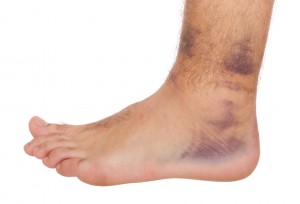Types of Soft Tissue Injuries
 Soft tissue injuries are incredibly common. All that it takes is one wrong move while playing a sport or participating in a physical activity of any kind, and you can incur a soft tissue injury. A fall, bump, or misguided twist can all lead to injury of your tendons, muscles, or ligaments, resulting in painful swelling.
Soft tissue injuries are incredibly common. All that it takes is one wrong move while playing a sport or participating in a physical activity of any kind, and you can incur a soft tissue injury. A fall, bump, or misguided twist can all lead to injury of your tendons, muscles, or ligaments, resulting in painful swelling.
Most soft-tissue injuries are mild and can be healed with rest and proper care. Do you think you or your loved one has incurred a soft tissue injury? In this blog we detail the different types of soft-tissue injuries and what to do for each one.
Common Soft-Tissue Injuries
There are a few different types of injuries that are all considered a soft-tissue injury, including:
- Strains
- Sprains
- Contusions
- Bursitis
- Tendonitis
- Stress related injuries
Strains: A strain is the result of an injury to your muscle or tendon. Muscles and tendons work together to support your bones, and tendons directly connect muscle to bone. Strains are most common in the foot and leg, strains range in severity from a small stretch to a complete or partial tear.
Treatment Options For Strains
In serious cases, surgery may be an option, but typically strains are healed with a healthy dose of rest, ice, compression, and elevation.
Sprains: When a ligament is stretched or torn this is considered a sprain, or a soft tissue injury. Ligaments are the strong connective tissues that attach one bone to another. There are 3 parts of the body that are more likely to become sprained, the wrists, knees, and ankles. A wrist is likely to strain if you fall on an outstretched hand, while strains to the knees and ankles usually relate to a sudden, excessive twist.
Treatment Options For Sprains
Sprains are generally treated with rest, ice, compression, and elevation (RICE). It takes some time but the body will heal itself, providing you with a new ligament.
Contusions: Also known as a bruise, a contusion is caused from impact that reaches your muscle, tendon, or ligament. Bruises form because blood pools around the area, altering the color of the skin.
Treatment Options For Contusions
In most cases, contusions are considered a mild injury that requires rest, ice, and compression in order to heal. If a bruise persists and does not go away, you may need to seek medical attention.
Bursitis: The reason your tendons are able to slide smoothly over your bones is all thanks to the bursa, a liquid filed sack situated between bones and tendons or muscles. If the bursa located in the shoulder, hip, elbow, ankle, or knee is overused it can begin to swell and hurt. Bursitis is often associated with tendonitis.
Treatment Options For Bursitis
Rest can often help relieve symptoms of bursitis on its own. In other cases, anti-inflammatory medications are used to help reduce swelling and pain.
Tendonitis: If your tendons are inflamed this is known as tendonitis. Inflammation is the body’s natural response to injury, and so when tendons are repeatedly overused they can become aggravated. Tendonitis can form in the arms and shoulders, or in the legs and feet. Professional tennis players, golfers, soccer and basketball players are just a few athletes that are highly susceptible to tendonitis due to the demands of their sport.
Treatment Options For Tendonitis
Depending on the cause and severity of your tendonitis, treatment options may vary. In some cases you only need to rest and eliminate stress, but in other cases anti-inflammatory medication, splinting, or steroid injections may be necessary. If tendons are continually inflamed they can become damaged and require surgery to correct.
Stress Fractures: When bones are overused they can develop small cracks known as stress fractures. Painful swelling is a common sign of stress fractures, and the areas most prone to this type of soft tissue injury include the lower legs and feet. An X-Ray and/or bone scan is required to know if you are suffering from stress fractures.
Treatment Options For Stress Fractures
Stress fractures are treated with rest, modification of activities, wearing a cast, and in very rare cases, surgery.
Tips To Prevent Soft Tissue Injuries
Soft tissue injuries are very common, especially if you are an athlete that continually pushes your body limits. There are a few things you can do to help limit your chances of developing an injury to your vital soft tissues:
- Be extra careful regarding parts of your body that have been previously injured, as they are more prone to becoming re-injured.
- Be mindful when working out or participating in any physical activity, you don’t want to push yourself past the point of exhaustion.
- Always stretch before physical exercise, tight un-stretched tissues are more likely to become injured.
If you are experiencing pain, swelling, or any other signs of a soft tissue injury, visit Urgent Medical Center today!

